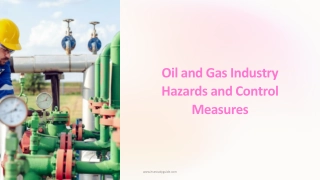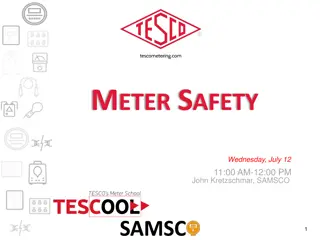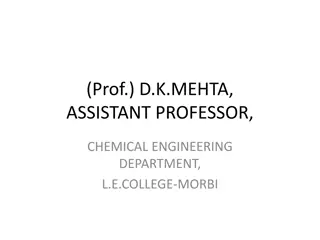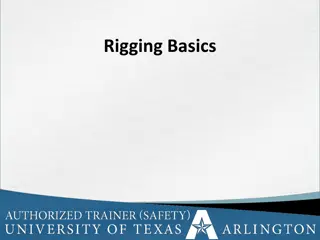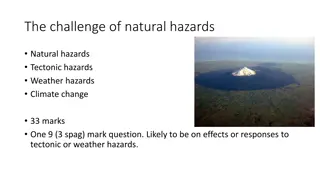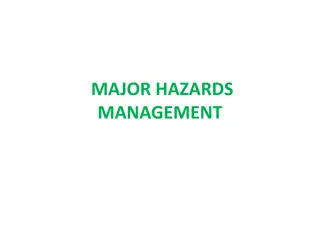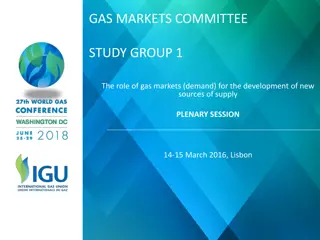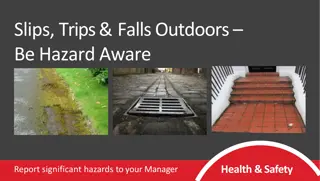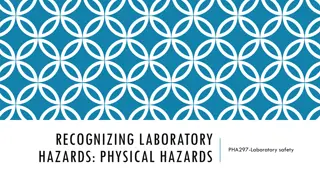Gas Transfer System Requirements and Hazards Overview
Gas transfer system requirements for SF6 include safe transfer between storage bags and high voltage tanks, with precautions to prevent gas loss or contamination. Hazards of SF6 include asphyxiation risk, cold burns, and toxicity. Material Safety Data Sheets and emergency protocols are essential for handling this non-flammable gas.
Download Presentation

Please find below an Image/Link to download the presentation.
The content on the website is provided AS IS for your information and personal use only. It may not be sold, licensed, or shared on other websites without obtaining consent from the author.If you encounter any issues during the download, it is possible that the publisher has removed the file from their server.
You are allowed to download the files provided on this website for personal or commercial use, subject to the condition that they are used lawfully. All files are the property of their respective owners.
The content on the website is provided AS IS for your information and personal use only. It may not be sold, licensed, or shared on other websites without obtaining consent from the author.
E N D
Presentation Transcript
6 Gas Transfer System Kevin Jordan and Carlos Hernandez Sept 2021
Overview Transfer System requirements Gas Hazards & MSDS Pressure Vessel Hazards Equipment layout & piping Gas Transfer Logic Storage Bag Location 9/14/2024 GTS Gas Transfer System Review 2
SF6 Transfer System Requirements The SF6 should be able to be transferred either automatically or manually between the storage bag and the high voltage tank and/or gun without significant loss of gas or contamination The HVPS tank has an instrument air connection for back filling after the SF6 has been transferred The tank pressure ion the tank must never exceed 15 PSIG, see pressure vessel section Tank must be evacuated prior to filling with SF6 Tank pressure relief is vented outside This will be reconnected to storage bag to capture any SF6 that leaks through relief 9/14/2024 GTS Gas Transfer System Review 3
SF6 Hazards & MSDS On Line MSDS(http://www.ncf.uic.edu/MSDS/SF6.pdf) EMERGENCY OVERVIEW: Sulfur Hexafluoride is a colorless, odorless, non-toxic, non-flammable gas which is shipped as a liquefied gas. The liquefied gas will rapidly boil at standard temperatures and pressures. The main health hazard associated with releases of this gas is asphyxiation, by displacement of oxygen. Contact with the liquefied gas can cause frostbite to any contaminated tissue. SF6 is not flammable or reactive under typical emergency response situations. ODH (Asphyxiant) in high concentrations Gas is heavier than air Contact with liquid may cause cold burns/frostbite. The hazard of asphyxiation is often overlooked and must be stressed during operator training 9/14/2024 GTS Gas Transfer System Review 4
SF6 Hazards & MSDS cont. 10. STABILITY and REACTIVITY STABILITY: Normally stable, inert gas. DECOMPOSITION PRODUCTS: Sulfur oxides and hydrogen fluoride. MATERIALS WITH WHICH SUBSTANCE IS INCOMPATIBLE: SF6 is non- reactive with most chemicals. SF6, however, can react violently with disilane. Sulfur Hexafluoride is only stable at elevated temperatures [e.g., 204 C (> 400 F)] when contained in aluminum, stainless steel, copper, brass, or silver. Other metals can cause slow decomposition to sulfur-fluoride compounds. If this decomposition occurs in the presence of oxygen, thionyl fluoride compounds can be generated. EVEN if there were arcing in HVPS tank the SF6 would not create thionyl fluoride compounds since it is not in the presence of Oxygen! See above We do not use the gas at elevated temperatures The gas is NOT present when the gun is baked The pumps used in the gas transfer do not reach these high temperatures 9/14/2024 GTS Gas Transfer System Review 5
SF6 Hazards & MSDS cont. 11. TOXICOLOGICAL INFORMATION TOXICITY DATA: The following data are for SF6: Standard human toxicity values are not available. Intravenous-Rabbit, adult LD50: 5790 mg/kg Male rats were exposed for periods of 16-24 hours to 20% oxygen and 80% SF6 at 1 atmosphere ambient pressure showed no changes. SUSPECTED CANCER AGENT: SF6 is not found on the following lists: FEDERAL OSHA Z LIST, NTP, CAL/OSHA, IARC; therefore it is not considered to be, nor suspected to be a cancer-causing agent by these agencies. IRRITANCY OF PRODUCT: Contact with rapidly expanding gases can cause frostbite and damage to exposed skin and eyes. SENSITIZATION OF PRODUCT: SF6 is not known to be a sensitizer in humans with prolonged or repeated exposure. REPRODUCTIVE TOXICITY INFORMATION: Listed below is information concerning the effects of SF6 on the human reproductive system. Mutagenicity: SF6 is not expected to cause mutagenic effects in humans. Embryotoxicity: SF6 is not expected to cause embryotoxic effects in humans. Teratogenicity: SF6 is not expected to cause teratogenic effects in humans. Reproductive Toxicity: SF6 is not expected to cause adverse reproductive effects in humans. 9/14/2024 GTS Gas Transfer System Review 6
SF6 Gas ODH Hazard Mitigation Storage bag is located outside of building Tank relief valve vents to the storage bag Any SF6 that might be released is mixed with building air In the event of a power failure AND gas release it would be dispersed down stairwell 9/14/2024 GTS Gas Transfer System Review 7
Tank Pressure Vessel Hazards This tank has been hydro d; pressure tested with water to 22 PSIG This tank is NOT a certified pressure vessel! Therefore there must be a relief of sufficient capacity to prevent the tank pressure from exceeding 15 PSIG to be in compliance with ASME codes REPEAT; The relief MUST keep tank pressure under 15 PSIG regardless of source gas The instrument air is used to back-fill tank once the SF6 has been transferred to the storage bag The supply line is interlocked to a tank pressure switch such that the air is shut down at 5 psig 9/14/2024 GTS Gas Transfer System Review 8
Equipment Configuration SF6 Pressure Transducer & Pressure Interlock Sw. Storage bag #8 Vent Outside High Voltage Tank #10 #2 #3 Thomas TA-210-P #1 12 PSI Relief #1 #3 #6 #9 #2 #7 #4 #5 Instrument Air Connection RUVAC WSU151 9/14/2024 GTS Gas Transfer System Review 9
Filling Tank with SF6 SF6 Pressure Transducer & Pressure Interlock Sw. Storage bag #8 Vent Outside High Voltage Tank #10 #3 #1 12 PSI Relief #6 #9 #2 #7 #4 #5 Instrument Air Connection 9/14/2024 GTS Gas Transfer System Review 10
Filling Tank with SF6 Evacuate tank to 125 Torr (25 in Hg Vac) Open valves & fill to 0 PSIG Close valves 2 & 3 Turn on pump to 10 PSIG Turn OFF pump & close valves; Process complete! 9/14/2024 GTS Gas Transfer System Review 11
Gas Transfer Logic; Fill Tank Tank open to air Initial conditions: HV Tank open to Air Evacuate tank; open valves 6 & 8, turn on pumps 2 & 3 until 125 Torr Close valves, turn off pumps 2 & 3 & open valves 1, 2, 3, 4, & 7 until 700 Torr in tank Turn on pump #1, close valves 2 & 3 When tank pressure reaches 10 PSIG turn off pump and close all valves High voltage power supply is ready for operation Evacuate tank venting outside No < 125 Torr YES Open SF6 back-fill valves No > 700 Torr YES Valve in & run Thomson pump YES No HVPS Ready for High Voltage Turn off pumps & close valves 10 PSIG 9/14/2024 GTS Gas Transfer System Review 12
Recovering SF6 SF6 Pressure Transducer & Pressure Interlock Sw. Storage bag #8 Vent Outside High Voltage Tank #10 #3 #1 12 PSI Relief #6 #9 #2 #7 #4 #5 Instrument Air Connection 9/14/2024 GTS Gas Transfer System Review 13
Recovering SF6 Open valves & drain tank to 0 PSIG Close valves 1, 4 & 7 Turn on pumps until tank @ 125 Torr Back-fill with Instrument Air to 0 PSIG Turn OFF pump & close valves Close valves; Process Complete! 9/14/2024 GTS Gas Transfer System Review 14
Gas Transfer Logic; Recover Gas Tank 10 PSIG SF6 Initial conditions: HV Tank @10 PSIG SF6 Equalize pressure, open valves 1, 2, 3, 4, & 7 When tank is 0 PSIG open valves 5, & 6, close valves 1, 4, & 7 turn on pumps # 1 & # 3 Evacuate tank; recovering gas until 125 Torr Shut off pumps & Close valves 2, 3, 5, & 6 Open valve 9 to back fill with instrument air When tank pressure reaches 0 PSIG close valve 9 High voltage tank is ready for maintenance Equalize pressure No 0 PSIG YES Open Valves & turn on pumps No > 125 Torr YES Turn off pumps Vent to Inst. air YES No Gun ready for maintenance Close valves 0 PSIG 9/14/2024 GTS Gas Transfer System Review 15
Design Issues Evacuating tank; water vapor contamination of vacuum pumps? The Thomas carbon vane pump (ultimate vacuum) is not low enough Has difficulty < 200 Torr; does not fully recover gas Is the RUVAC WSU151 the correct pump? Is the tank pressure low enough to be effective? Can it be used with the Thomson pump to help recover gas? What is the correct pump to back the blower? New relief must be installed with release pressure of 13 PSIG Instrument air supply line must be sized such that if left open the relief will limit the tank pressure less than 15 PSIG 9/14/2024 GTS Gas Transfer System Review 16



